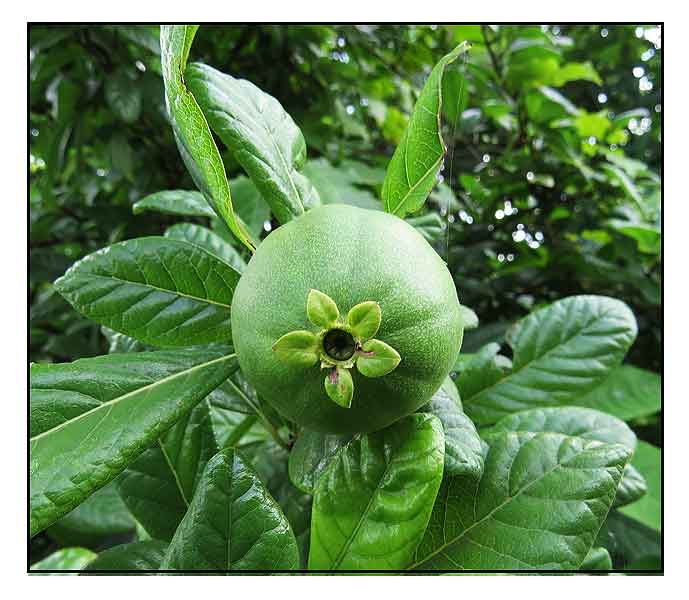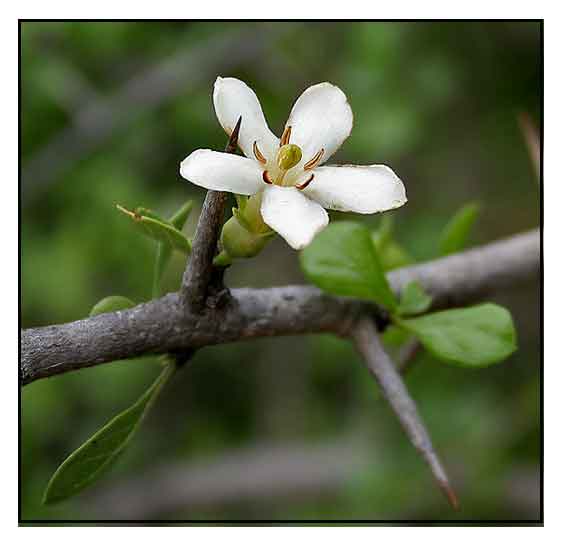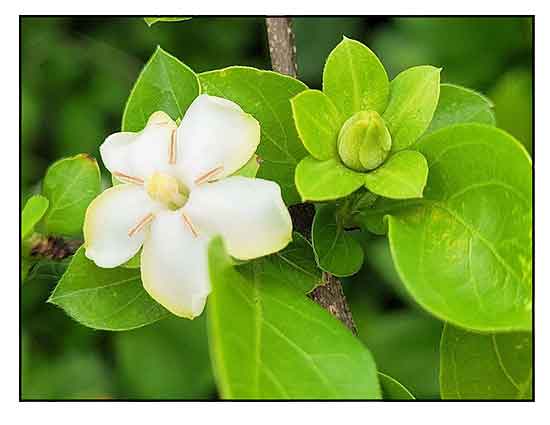 Gen info Gen info
- Catunaregam spinosa, the mountain pomegranate, is a flowering plant in the family Rubiaceae, found in South Asia and other Asian countries.
- The Indian name "gelphal" translates as "first-day flower", appearing white at first, and "second-day flower" when it turns yellow the following day. (28)
Botany
Randia dumetorum is a small deciduous tree, shrubby with stout axillary spines, Leaves as fascicled on suppressed branches, 3.2 - 6.7 cm long, simple, obovate, ovate or ovate-lanceolate, roundish or shortly obtuse, and wrinkled. Flowers are fragrant, subsessile in axillary fascicles; corolla 2 cm long, at first white, later becoming yellow, Fruit is a yellow berry when ripe, globose or broadly ovoid, about 4 cm across, smooth or obscurely longitudinally ribbed, crowned with a large calyx limb. Seeds are many. flat, about 4 mm long, angular.
Distribution
- Introduced. (?)
-
Found in the coast of Luzon.
- Native to Bangladesh, Cambodia, China, Hainan, Himalaya, India, Jawa, Laos, Malaya, Myanmar, Nepal, Pakistan, Sri Lanka, Taiwan, Thailand, Vietnam. (1)
 Constituents Constituents
- Phytochemical screening of methanol extract of bark and leaves yielded flavonoids, terpenoids, phenols, carbohydrates, and glycosides, with absence of alkaloids and saponins. (see study below) (6)
- Phytochemical screening of various leaf fractions yielded glycosides, flavonoids, reducing sugars, saponins, phenolic compounds, tannins, with absence of gums and mucilage, alkaloids protein, and amino acid. (see study below) (9)
- Phytochemical of leaves for secondary metabolites yielded alkaloids, carbohydrates, proteins and amino acids, tannins, saponins, flavonoids, and glycosides. ( see study below) (15)
- GC-MS study of ethyl acetate extract of leaves yielded triterpenoid esters, cinnamate, naphthalene, phenolic compounds mainly BHT,
while a methanol fraction yielded triterpenoid esters, amines, and coumarins, mainly 5a-methoxy-9a-methyl-3-(1-propenyl)perhydro-pyrano[4,3-b]bemzopyran-1,9-dione. (18)
- Studies have yielded secondary metabolites: iridoid glycosides, randinosides, galioside, deacetylasperulosidic acid methyl ester, scandoside methyl ester, geniposide, gardenoside. (26)
- Study of C/ spinosa stem bark isolated two novel norneolignans, catunaregin (1) and epicatunaregin (2), along with three known neolignans, ficusal, balanophonin, and 5"-methoxy-4"-O-(8-guaiacylglycerol)buddlenol A. (see study below) (34)
Properties
- In Ayurveda, fruit considered anti-inflammatory, emetic, and abortifacient.
- Considered antibacterial, antiviral, anti-inflammatory.
- Studies have suggested antioxidant, antidiabetic, antilipidemic, anti-allergic, anti-inflammatory, antibacterial, antifungal, hepatoprotective, anticancer, emetic, sedative, antihelmintic properties.
Parts used
Fruit, bark, roots, leaves.
 Uses Uses
Edibility
- Fruit is edible, eaten raw or as vegetable. (24)
Folkloric
- The pulp of the fruit, dried and powdered, is used as an emetic, as substitute for ipecacuanha (Cephaelis ipecacunha), useful as nervine calmative and antispasmodic. (24)
- In Ayurveda, used to vitiated pitta and kapha/mucous, and for treatment of cough, skin diseases, ulcers, asthma, flatulence, colic. Fruit used to induce emesis (vomiting). Fruit considered anti-inflammatory and abortifacient. Tree bark applied externally to relieve pain of bruises and rheumatism.
(2)
- Fruit used to treat abscesses, wounds, tumors ulcers. Fruit pulp used as anthelmintic; also as abortifacient. Bark is astringent, used to treat diarrhea and dysentery. Bark applied externally as a paste to treat rheumatism and pains associated with bruises and bone pains of fever. Extract of root bark used as insecticide. (3)
- In the tribal areas of the Kodagu district of Karnataka, India, the plant roots and leaves of Acacia suma are pounded with salt and applied to snake bites and scorpion stings. (10)
- Fruit used for treatment of helminthiasis.
- Leaves used in traditional medicine for the treatment of diarrhea, dysentery, snake bite, wound healing, inflammation, tumors, piles, intestinal and skin diseases. (15)
- In Indo-China, powdered and roasted fruits (without seeds) used externally to treat ulcers; the bark used internally to treat diarrhea and dysentery, and to regulate menstruation. In India, bark is used to treat diarrhea and dysentery. (27)
- In Africa, used to treat bronchitis, asthma, leucoderma and diseases of the brain; the fruit used for poulticing sores. Root decoction applied directly on melanomas; infusion used orally as emetic, and to treat fevers, nausea, cough, toothache, pains during pregnancy, dizziness, menorrhagia, snake bites and gonorrhea. (27)
Others
- Fish poison: In India, fruits used for fish poisoning. (10) In India, Nepal, and Africa, bark and fruits used as fish poison. (27)
Studies
• Immunomodulatory / Fruits: Study evaluated the immunomodulatory activity of methanol extract and various fractions of fruits of R. dumetorum. Effects on cell mediated and humoral components of the immune system in mice were observed. A chloroform fraction at a dose of 100 mg/kg produced statistically significant results as evidenced by increase in humoral antibody (HA) titer (p<0.05) and delayed type hypersensitivity (DTH) response. The fraction also enhanced the total WBC level in cyclophosphamide induced myelosuppression model (p<0.001) at dose of 100 m,g/kg. Results suggest promise as an immunomodulatory agent. (4)
• Mechanism of Emetic Action: In-silico and in-vitro study seeks to evaluate the molecular mechanism of the emetic action of identified phytochemical compounds in madanaphala medicinal plant (R. dumetorum). Study aimed to identify the active compounds in seeds mediating emetic action on binding towards 5HT3 and ML receptors. (5)
• Antioxidant / α-Amylase Inhibitory Activity / Leaves and Bark: Study evaluated the alpha-amylase inhibitory activity of methanolic extracts of R. dumetorum from bark and leaves. The extracts exhibited antioxidant and alpha-amylase inhibitory activities. (see constituents above) (6)
• Hepatoprotective / Antioxidant / Leaf and Bark: Study evaluated the methanol extracts of leaf and bark of Randia dumetorum for antioxidant and hepatoprotective activity. Results showed good antioxidant activity by DPPH assay. Total phenolic and flavonoid contents were 112 ± 3.24 mg and !38 ± 2.46 mg gallic acid equivalents/g and 2,6 ± 0.26 mg and 3.34 ± 0.31 mg rutin equivalents /g extract, respectively for RD leaf and bark methanol extracts. The hepatoprotective activity of leaf and bark against carbon tetrachloride induced hepatic damage in male wistar rats was evidenced by reversal of all abnormal biochemical parameters to significant levels, along with histopathological evidence. (7)
• Antibacterial / Fruits: Study evaluated the antibacterial activity of crude extracts of R. dumetorum fruits using disc diffusion method by quantitation against E. coli, B. subtiliis, S. aureus, and S. typhi. Highest antibacterial activity was exhibited by chloroform and petroleum ether fraction against all the investigated phytopathogens. Phytochemical screening of of these fractions yielded terpenoids and steroids. (8)
• Cytotoxicity / Antioxidant / Leaves: Study evaluated the antioxidant potential and cytotoxicity of various fractions of leaf extract of Randia dumetorum. All the extracts showed significant antioxidant activity by reducing power assay, total antoxidant capacity, total phenolic and flavonoid contents. The methanol and water extracts showed significant cytotoxic activity by brine shrimp lethality test. (9)
• Antidiabetic / Fruits: Study evaluated the antidiabetic and antihyperlipidemic activity of Randia dumetorum fruit extracts using nicotinamide and alloxan induced diabetic rats. Diabetic rats treated with the extract and gliclazide showed significantly decreased glucose levels. (11)
• Lipid Lowering Activity in Induced Hyperlipidemia: Study evaluated the lipid lowering activity of Randia dumetorum fruit extracts and Paederia foetida aerial part extract in Triton WR-1339 induced hyperlipidemia in male albino rats. Results demonstrated the R. dumetorum fruit extract is a potent lipid lowering agent. with none of the side effects of currently available hypolipidemmic drugs. Compared with P. foetida, it showed comparatively better hypolipidemic activity. (12)
significantly decreased glucose levels. (11)
• Effect on Clonidine and Haloperidol Induced Catalepsy: Study evaluated the anticataleptic efficacy of ethanolic extract of Randia dumetorum fruits in clonidine and haloperidol induced catalepsy in mice. Cataleptic score was measured as the time maintained an imposed posture. In the clonidine induced catalepsy model there was significant (p<0.01) reduction in catalepsy score. However, there was no significant reduction in the haloperidol catalepsy model. The cataleptic activity was attributed to antihistaminic activity. Randia dumetorum does not possess antidopaminergic and antiserotonergic activity. (13)
• Anthelmintic / Fruit: Study evaluated the anthelmintic activity of different extracts prepared from fruits of R. dumetorum against adult earthworm Pheretima posthuma in measures of time of paralysis and time of death. Albendazole was used as standard reference drug. Among the extracts, the ethanol fruit extract showed better anthelmintic activity. (14)
• Antioxidant / Leaves: Study of ethanol and aqueous extracts of leaves showed good dose dependent free radical scaveng9ing property, with the aqueous extract showing more activity than the ethanol extract. (see constituents above) (15)
• Sedative / Acute Toxicity Study / Stem Bark: Study evaluated the sedative activity of aqueous and ethanol extracts of Catunaregam spinosa in Swiss albino mice in two models viz. potentiation of thiopentone-induced seeping time and locomotor activity using Actophotometer. Elevated plus-maze was used in Wistar albino rat model. Acute toxicity study of both extracts showed safety up to a dose of 2000 mg/kbw in Swiss albino mice by oral route administration. Both extracts exhibited significant potentiation of thiopentone-induced sleeping time and reduction in locomotor activity. HPTLC studies revealed the presence of triterpenoid and saponin compounds in both extracts. (16)
• Piscicidal / Ripe Fruits: The fruit of Catumaregam spinosa and leaves of Polygonum hydropiper possess fish toxins of potential value to aquaculture. Aqueous extracts of dried, ripe fruits of C. spinosa tested under laboratory conditions showed a 5h LC40 0.0036% (weight/volume) for the tropical air-breathing fish, Heteropneustes fossilis, Similar results were observed in a farm pond. (17)
• Antimicrobial Formulation / Endocarp: Study evaluated the antimicrobial activity of Randia spinosa against Staphylococcus aureus, Streptococcus nutans, Aspergillus niger, and Candida albicans. Standards used were Ciprofloxacin and Amphotericin B. The petroleum ether extract of endocarp showed significant antimicrobial activity against bacteria and fungi tested. (19)
• Antidiabetic / Leaves: Study of Randia dumetorum showed antidiabetic activity on STZ induced diabetic rats. STZ-induced hyperglycemia was attributed to hepatic glycogenolysis and gluconeogenesis and decrease utilization of glucose by the tissues. The study suggests the leaves extract has both hypoglycemic and hypolipidemic effects. (20)
• Cytotoxic Triterpene / Bark: Study of Randia dumetorum bark isolated α-L-arabinosyl (1-->3)-3-ß-galactopyranosyl (1-->3) -3-ß-hydroxyolean-12-en-28-methyloate (compound 1). The compound was evaluated for cytotoxicity against various cancer cell lines i.e., MDA-MB-231 (Breast cancer cell line) and SK-MEL-2 (Human skin melanoma cell line), BE(2)C (Neuroblastoma cell line) and U87MG (Human neuronal glioblastoma cell line). Results showed cytotoxicity increased with increase in compound concentration, with the compound showing potent activity against SK-MEL-2 (Human skin melanoma cell line) with minimum IC50 value of 93.33 µg/ml. (21)
• Hepatoprotective / Alcohol-Induced Damage / Fruit: Study evaluated the hepatoprtective effect of methanolic fruit extract in alcohol-induced liver damage in rats. Randia dumetorum increased the levels of total protein and reduced glutathione and significantly decreased the elevated levels of liver enzymes, total bilirubin, triglycerides and lipid peroxidation. (22)
• Binding Properties of Fruit Mucilage / Fruit: Study reported on the extraction of mucilage from Randia dumetorum fruit and its suitability as a tablet binder. The tablets prepared with R. dumetorum fruit mucilage as binder showed good results, with a profile comparable to that of standards and complied with pharmacopoeial limits. Results suggest the fruit can act as suitable binder for conventional tablets instead of synthetic polymers. (23)
• Anti-Allergic / Anti-Inflammatory / Fruit: Study evaluated the anti-allergic and anri-inflammatory activity of R. dumetorum extract and fraction on milk induced leucocytosis and eosinophilia in mice, passive paw anaphylaxis, and mast cell degranulation in rat models. The extract and its fractions significantly inhibited the passive paw edema and mast cell degranulation in rats. The methanol extract showed significant (p<0.01) dose dependent activity. Among the fractions the chloroform fraction showed most significant activity. (25)
• Silver Nanoparticle / Antioxidant, Antimicrobial, Anticancer / Fruit: Study reports on the synthesis of silver nanoparticles (AgNPs) using C. spinosa unripe fruit aqueous extract. Antioxidant evaluation using DPPH and ferric reducing antioxidant power confirmed the AgNPs have more antioxidant activity than ascorbic acid. The NPs showed strong antibacterial activity, maximum against S. aureus (21 mm), minimum with Streptococcus pyogenes (14 mm), and antifungal activity against Candida tropicalis (18 mm) and C. albicans (13 mm). MTT assay showed dose-dependent effect against lung cancer cell line A549. (29)
• Inhibiting Effect and DNA Damage on Aedes aegypti / Targeted Vector Control: Study evaluated the possibility of reducing vectorial capacity by eliminating microbial consortia of Ae. aegypti larvae and damages of genomic DNA and alteration of morphological appearance of Ae. aegypti larvae with excess formation of free radicals. Formation of free radicals was confirmed using ammonium molybdate method. Various extracts of C. spinosa exhibited potent toxicity towards Ae. aegypti larva gut bacterial microbiota, including S. aureus, B. subtilis, E. coli, K. pneumonia and P. mirabilis with strong MICs ranging from 0.07 to 5.9 mg/ml. The extract induced free radical formations and oxidative damage to DNA. Results suggest probably mechanisms underlying the lethal effect of C. spinosa extract on Ae. aegypti and its potential as a novel biological vector control approach. (30)
• α-Amylase Inhibitory Activity / Leaves and Bark: Study evaluated the invitro α-amylase inhibiting properties of methanol extracts and fractions of leaves and bark of C. spinosa. The invitro α-amylase inhibition assay of the dichloromethane fraction of bark extract (IC50 77.17 µg/mL) was more potent compared to the hexane and ethyl acetate fractions. In silico molecular docking study showed previously reported compounds from the stem bark such as balanophonin, catunaregin, ß-sitosterol, and medioresinol were bounded well with active catalytic residue of porcine pancreatic α-amylase indicating better inhibition. (31)
• Anti-Inflammatory / Analgesic / Leaves: Study evaluated the anti-inflammatory, analgesic, and antipyretic potential of leaves of C. spinosa. At 200 mg/kg, there was 32,06, 37.28, and 43.16% inhibition at 1, 3, and 5 h; while in the egg albumin model % inhibition was 47.81%. There was significant analgesic effect on hot plate test at doses of 25 and 100 mg/kg, with no significant analgesic effect in acetic acid induced writhing method. No antipyretic effect was seen against Brewer's yeast induced pyrexi in rats. (32)
• Antioxidant / Hypoglycemic / Dexamethasone Induced Diabetes: Study evaluated the hypoglycemic and antioxidant effect of C. spinosa against dexamethasone-induced diabetes in wistar rats. Results showed significant alteration in serum glucose, HbA1c. total proteins, serum lipid profile and tissue antioxidant parameters compared to control rats. In groups treated with extract and glibenclamide, there was significant alteration of altered parameters and antioxidant parameters like SOD, CAT, GSH, and MDA. (33)
• Norneolignans / Anticancer: Study of C/ spinosa stem bark isolated two novel norneolignans, catunaregin (1) and epicatunaregin (2), along with three known neolignans, ficusal, balanophonin, and 5"-methoxy-4"-O-(8-guaiacylglycerol)buddlenol A. Compounds 1 and 2 exhibited moderate inhibition against mammary cancer F10 cell line. (34)
α-amyrin,
y - gamma
γ
δ
α-amyrin,
y - gamma
γ
δ
α
Availability
Wild-crafted.
Emetic nut powder in the cybermarket. |

![]()






